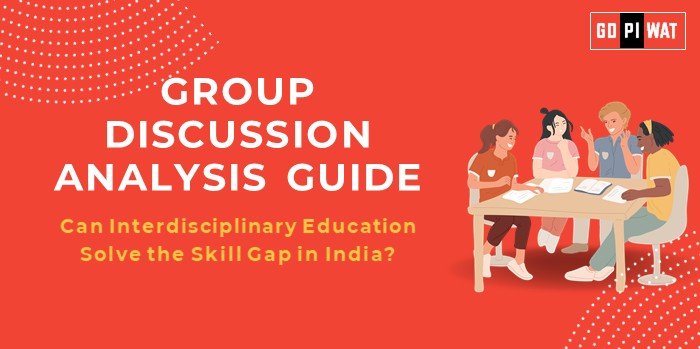📋 Can Interdisciplinary Education Solve the Skill Gap in India?
🌐 Introduction to the Topic
Opening Context: Interdisciplinary education integrates knowledge across disciplines to prepare students for dynamic job markets, making it a potential solution to India’s persistent skill gap.
Topic Background: India’s education system traditionally emphasizes specialization, often leaving graduates unprepared for cross-functional roles. Recent shifts toward interdisciplinary approaches aim to align education with industry needs, fostering adaptability and innovation.
📊 Quick Facts and Key Statistics
- 📚 Interdisciplinary Push: NEP 2020 recommends breaking disciplinary silos.
- 📈 STEM + Arts Growth: 20% increase in admissions for interdisciplinary programs in India since 2021 (AISHE).
- 🌍 Global Benchmark: Countries like Finland and the US integrate interdisciplinary curricula early in education, enhancing employability.
🤝 Stakeholders and Their Roles
- 🏛️ Government: NEP implementation, funding initiatives, and creating policy frameworks.
- 🏫 Educational Institutions: Curriculum design, faculty training, and fostering collaborative research.
- 🏢 Industry: Defining skill requirements and offering internships or apprenticeships.
- 👨🎓 Students and Parents: Advocating for modernized education paths that blend diverse fields.
🏆 Achievements and ⚠️ Challenges
✨ Achievements:
- 📜 NEP 2020: Recognizes interdisciplinary education as a priority.
- 🤝 University-Industry Collaborations: Examples include IITs partnering with corporations for multi-disciplinary programs.
- 💻 Rise of Ed-Tech Platforms: Platforms offering courses that combine coding with design or AI with humanities.
⚠️ Challenges:
- 👨🏫 Faculty Training: Lack of educators skilled in interdisciplinary methodologies.
- 🏛️ Traditional Frameworks: Resistance from long-established academic structures.
- 🏫 Infrastructure Gaps: Resource limitations in tier-2 and tier-3 cities.
🌍 Global Comparisons:
- 🇫🇮 Finland: Emphasizes skill-based learning from the primary level, fostering adaptability and innovation.
- 🇺🇸 United States: Liberal arts education integrates sciences and humanities, producing well-rounded graduates.
- 📉 Skill Gap: 75% of Indian graduates are considered unemployable in high-demand industries (NASSCOM, 2023).
- 📚 Interdisciplinary Push: NEP 2020 recommends breaking disciplinary silos.
- 🚀 STEM + Arts Growth: 20% increase in admissions for interdisciplinary programs in India since 2021 (AISHE).
- 🌍 Global Benchmark: Countries like Finland and the US integrate interdisciplinary curricula early in education, enhancing employability.
- 🏛️ Government: NEP implementation, funding initiatives, and policy frameworks.
- 🏫 Educational Institutions: Curriculum design, faculty training, and collaborative research opportunities.
- 🏢 Industry: Defining skill requirements and offering internships or apprenticeships.
- 👨🎓 Students and Parents: Advocating for modernized education paths that blend diverse fields.
- 📜 NEP 2020 Priority: Recognizes interdisciplinary education as a solution for employability.
- 🤝 University-Industry Partnerships: IITs collaborating with corporates for multidisciplinary courses.
- 📈 Rise of Ed-Tech Platforms: Courses combining coding with design or AI with humanities are on the rise.
- 🎓 Faculty Shortages: Lack of trained faculty to implement interdisciplinary teaching methodologies.
- 🏛️ Traditional Frameworks: Resistance to change in conventional academic systems.
- 🏫 Resource Constraints: Infrastructure challenges in tier-2 and tier-3 cities hinder adoption.
- 🇫🇮 Finland: Emphasizes skill-based learning from primary education, fostering adaptability.
- 🇺🇸 The US: Liberal arts education integrates sciences and humanities, enhancing cross-disciplinary skills.
- Supporting Stance: “Interdisciplinary education equips students with diverse skill sets, bridging gaps between theoretical knowledge and practical application.”
- Opposing Stance: “Overemphasis on interdisciplinary education may dilute depth in core disciplines, leading to superficial expertise.”
- Balanced Perspective: “Interdisciplinary education is essential but must complement deep domain expertise to ensure effectiveness.”
- 📊 Data-Driven: “With 75% of graduates unemployable due to a mismatch between education and industry needs, interdisciplinary education can address this crisis.”
- 🌍 Comparative: “Countries like Finland leverage interdisciplinary frameworks; India has the potential to replicate this success.”
- 📖 Anecdotal: “An Ashoka University graduate blending design and AI secured a role in a leading global tech firm—proof of interdisciplinary education’s relevance.”
- 💡 Balanced View: Acknowledge concerns about depth but emphasize how specialization can coexist within interdisciplinary frameworks.
- 🌍 Global Examples: Highlight Finland and the US as success stories demonstrating interdisciplinary education’s value.
- 💪 Strengths: Improved employability, innovation-friendly education, NEP’s strong policy support.
- 🔻 Weaknesses: Resource shortages, lack of faculty training, slow adoption in rural areas.
- 🚀 Opportunities: International collaborations, leveraging ed-tech platforms to offer scalable solutions.
- ⚠️ Threats: Resistance to change, concerns over potential skill dilution in core disciplines.
- 🛠️ Operations: Leveraging interdisciplinary skills for cross-functional team efficiency.
- 📊 Development: Addressing workforce skill gaps through interdisciplinary approaches.
- 💼 “How can interdisciplinary education enhance employability?”
- 📚 “Evaluate the role of NEP 2020 in promoting skill development.”
- 🚀 Leverage interdisciplinary skills during internships to develop innovative solutions.
- 🛠️ Design projects blending diverse domains like fintech, health-tech, or edu-tech for real-world impact.
📋 Can Interdisciplinary Education Solve the Skill Gap in India?
🌐 Group Discussion (GD) Analysis Guide
💡 Introduction to the Topic
Opening Context: Interdisciplinary education integrates knowledge across disciplines to prepare students for dynamic job markets, making it a potential solution to India’s persistent skill gap.
Topic Background: India’s education system traditionally emphasizes specialization, often leaving graduates unprepared for cross-functional roles. Recent shifts toward interdisciplinary approaches aim to align education with industry needs, fostering adaptability and innovation.
📊 Quick Facts and Key Statistics
🤝 Stakeholders and Their Roles
🏆 Achievements and ⚠️ Challenges
✨ Achievements:
⚠️ Challenges:
🌍 Global Comparisons:
Case Studies:
🎓 Ashoka University: Successfully combines liberal arts and sciences to produce versatile graduates.
💡 IIT-Madras: Launched an interdisciplinary BS in Data Science, merging computing and humanities.
🗣️ Structured Arguments for Discussion
💬 Effective Discussion Approaches
🔹 Opening Approaches:
🔄 Counter-Argument Handling:
📊 Strategic Analysis of Strengths and Weaknesses
📚 Connecting with B-School Applications
Real-World Applications:


